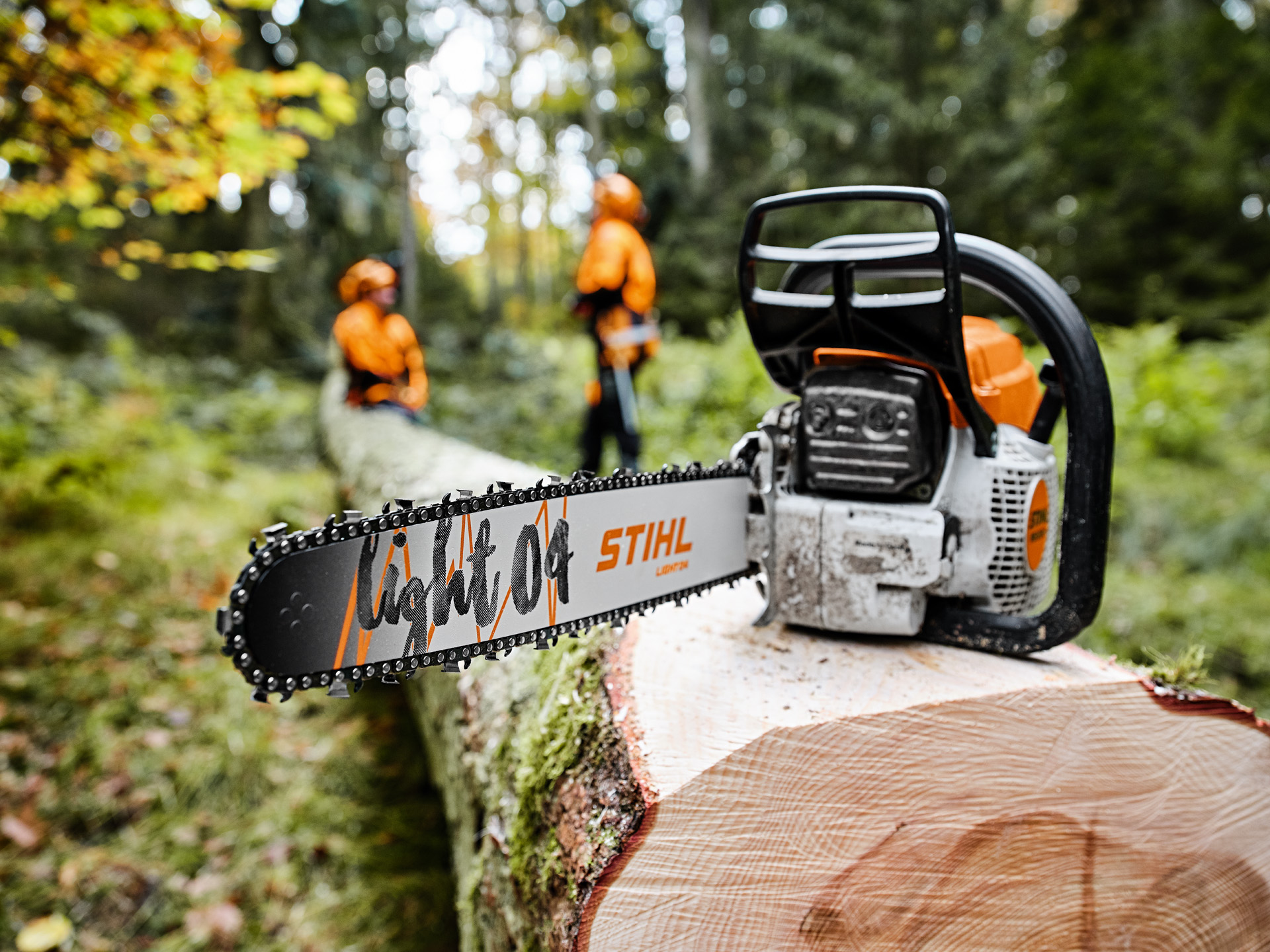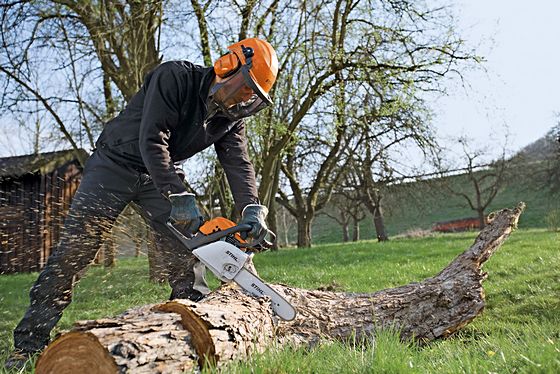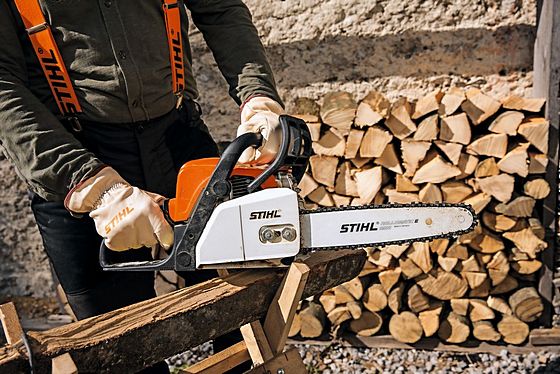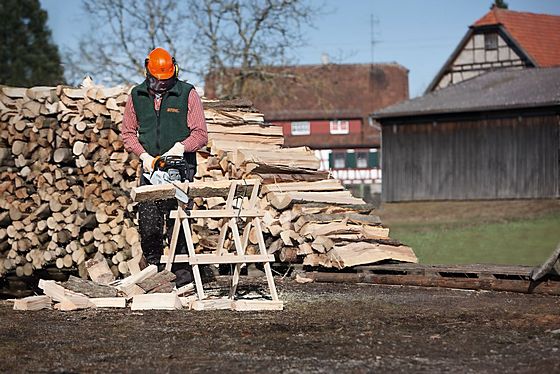With the weather turning a little bit chillier, your thoughts might be turning to keeping the house warm?
My mum always told me to put another jumper on if it was cold in our house when I was younger, but if you are looking for a solution that is less Michelin man and more macho man, why not consider sawing your own firewood? Once a tree is felled, the firewood your produce will need at least a year to season and dry out but if you do have a ready supply of timber, this is a great way to keep your home heated.
If you haven’t done this before, we've put together some of our favourite sawing firewood tips.

Protective clothing from head to toe
First things first – when sawing firewood you need to ensure you start with the right equipment. Personal Protective Equipment should be top of that list. Whenever you are working with a chainsaw you should wear face protection and safety glasses to protect your face and eyes from flying wood chips. If you're using a petrol chainsaw, you will also need ear protection, such as ear plugs or ear defenders.
For those with more sensitive ears, you can always consider a cordless chainsaw – they are so quiet that they do not require ear protection.
The Stihl MSA 120 C-B, MSA 140 C-B and MSA 200 C-B battery chainsaws have all been awarded a QuietMark, which means they are some of the quietest saws on the market.
You should also protect your hands, legs and feet properly by wearing appropriate cut protective work gloves, chainsaw trousers and boots.
Which Firewood?
If you don’t use your fireplace often, most wood will be suitable. Soft woods, such as spruce, will heat up faster, due to their higher resin content. This also means that they burn more quickly so you will need to add logs to the fire more often.
Hard woods, such as beech or oak, take longer to heat up but burn for much longer. This makes them well suited if you use your stove or fireplace for longer periods of time.
Make sure the wood is seasoned (dried out) before burning it. For the best burn and heat output, firewood should be seasoned until its moisture content is around 20 percent. Firewood with a higher moisture content is hard to light and keep burning, plus the heat that is produced is wasted in drying the excess moisture. More importantly, the tars and creosote in the smoke produced by the excess moisture can line flue pipes and your chimney and eventually cause a fire. Plus lots of smoke is never a good thing for you or your poor neighbours.
Sawing firewood from a trunk on the ground
So you have a tree trunk or large branch in your garden that can be turned into fuel for your soon-to-be roaring fire? We suggest that you start by cutting the tree, log or branch into much more manageable lengths – one metre lengths work well.

- Lay out the trunks and mark one metre lengths on the bark so that you know where you need to cut. Stihl have marking chalk (which has high pigmentation so you can see your marks) or ECO Marker spray – both are perfect for this job.
- If the trunk is on a fairly firm surface, you can cut the trunk to length where it is. However, before you start sawing, make sure that it cannot roll away. Small pieces of wood can be used to hold it in place.
Sawing the trunk
1. Start your chainsaw and position it on the marked points with the chain running slowly. Saw about three-quarters of the way through the trunk at each marked point. This prevents you from cutting into the ground with the chainsaw – cutting into the ground will blunt your chain, which can be dangerous.
2. Turn the trunk over, either by hand or with a felling lever. Once again, check that the trunk cannot roll away and wedge it if necessary.
3. Saw through the remaining parts of the trunk at each of the marked sections.
You can see these steps in action in this informative video by Stihl...
Sawing firewood from a trunk on a support
If the ground is not as stable, a self-made support could be the answer. Cutting a groove in a piece of wood creates an ideal support. Follow these step-by-step instructions.
1. To make the support, you will need a small piece of the trunk. Saw a V-shaped groove into it (as in the above picture). The groove should be the same width of the tree trunk you want to cut.
2. Make sure the support is stable then place the trunk on it. Hand lifting tongs might be useful here. You do not want the trunk to move.So ensure it is stable and wedge it in place if not.
3. Position your saw on the marked points with chain running slowly – this will help to achieve a clean cut. At this point, watch out for where the sawn-off part of the trunk falls – if it falls on your foot, your toes won’t know what’s hit them!
4. Keep moving the trunk further up the support and repeat the process until all marked sections have been cut.
So you will now have several one-metre lengths which will be more manageable. But unless you have a very big fireplace, these lengths now need to be cut into smaller pieces. Smaller logs also dry more quickly and you will definitely want dry logs for your fire. Damp logs will smoke and cause soot – not ideal in your living room!

- Place your one-metre log horizontally and securely on the ground. At the risk of sounding like a broken record, again ensure that it cannot roll away.
- Next, cut the log down the middle along its entire length. Don’t try and cut all the way through the log – this could result in you cutting into the ground and blunting the chain. Leave approximately 5-10 centimetres of the log intact.
- You can then prise the log in two using a splitting wedge. You can cut an indent into the log to fit the wedge into, which will make it easier. It is easiest to use the wedge if an indent for the wedge is first cut into trunk.
- Depending on the thickness of the trunk, you may want to split the log halves again. If so, just follow steps 1 – 3 again.
Making thin trunks, branches & split pieces into firewood
 Once your one-metre lengths have been split into thinner lengths (or if your branches were fairly thin in the first place) we suggest that you use a sawhorse. A wooden sawhorse (like the one pictured) is perfect for the job and is a great budget option.
Once your one-metre lengths have been split into thinner lengths (or if your branches were fairly thin in the first place) we suggest that you use a sawhorse. A wooden sawhorse (like the one pictured) is perfect for the job and is a great budget option.
Once you have cut your own logs, they will need to dry for 1-2 years before they can be used on the fire (softwoods will season quicker than hardwoods, such as oak, which will likely need the full two years). Make sure that you stack your logs so that the air can circulate between them. Then cover them with a waterproof tarpaulin to protect them from rain and damp weather.
So there you have it – our tops tips for sawing firewood!
If you're in the market for a new Stihl chainsaw, contact Balmers GM and speak to one of our product experts!
